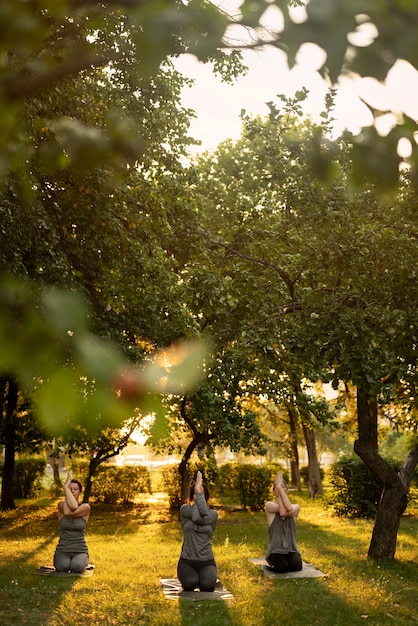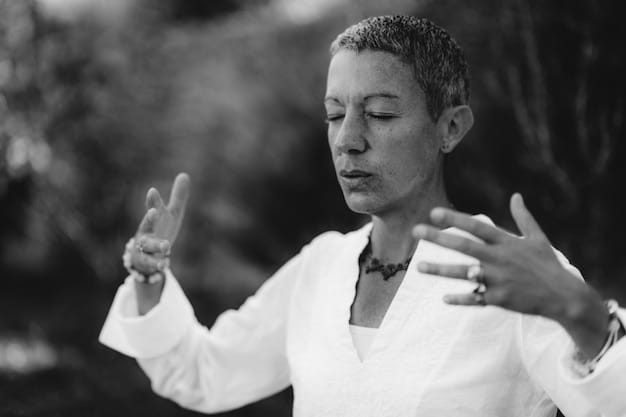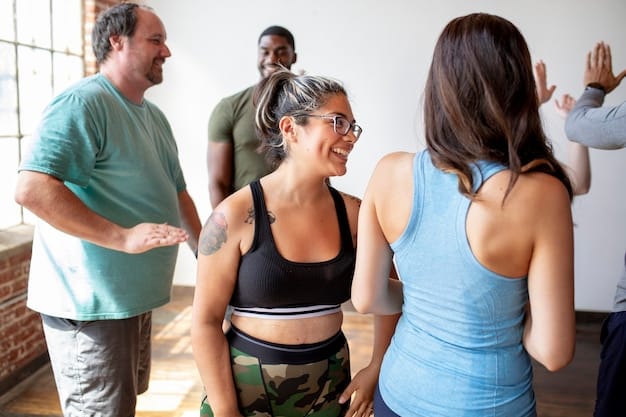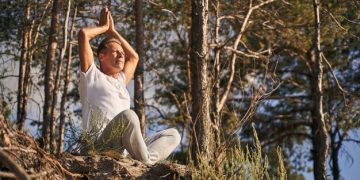Beyond Yoga: Top 3 Movement Practices for Stress Relief in 2025

Beyond yoga, explore three alternative movement practices—Tai Chi, Pilates, and dance therapy—to effectively manage stress and enhance well-being in 2025.
Feeling stressed? While yoga is a popular choice, 2025 offers exciting alternatives for stress relief. Discover three movement practices beyond yoga: 3 alternative movement practices for stress relief in 2025 that can help you unwind and improve your overall well-being.
Unlock Stress Relief: Alternative Movement Practices in 2025
Stress management is a crucial aspect of maintaining overall health and wellness. While conventional methods like yoga are widely embraced, exploring alternative movement practices can offer unique benefits and appeal to a broader range of individuals. In 2025, several practices are gaining traction for their effectiveness in reducing stress and promoting relaxation.
Let’s delve into three impactful alternatives, each offering a distinct approach to stress relief.
Why Explore Alternatives to Yoga?
Yoga is fantastic, but it’s not for everyone. Some people find it too slow-paced, while others struggle with its physical demands. Exploring alternatives allows you to discover a practice that truly resonates with your body and mind.
Benefits of Movement for Stress Relief
Movement, in general, releases endorphins, which have mood-boosting effects. Regular physical activity can also improve sleep quality, reduce muscle tension, and enhance focus, all contributing to stress reduction.
- Provides a change of pace and scenery from traditional workout routines.
- Engages different muscle groups and movement patterns.
- Offers a unique approach to mindfulness and body awareness.
- Can be adapted to various fitness levels and preferences.
Ultimately, the best stress-relieving movement practice is the one you enjoy and can consistently incorporate into your routine. The key is to find activities that will promote relaxation and help to improve your overall well being.

Tai Chi: The Gentle Art of Moving Meditation
Tai Chi, often described as “meditation in motion,” is an ancient Chinese martial art known for its slow, graceful movements. This practice involves a series of flowing postures that promote relaxation, balance, and mental clarity. In 2025, Tai Chi is becoming increasingly popular as a form of stress relief due to its gentle nature and profound effects.
Let’s explore how Tai Chi can benefit you.
How Tai Chi Reduces Stress
The slow, deliberate movements of Tai Chi encourage deep breathing and focused attention. This combination helps to calm the nervous system, reduce anxiety, and promote a sense of inner peace. Engaging in Tai Chi also cultivates mindfulness, allowing practitioners to become more present and aware of their thoughts and emotions.
Benefits of Practicing Tai Chi
Beyond stress reduction, Tai Chi offers numerous physical and mental health benefits. It can improve balance and coordination, increase muscle strength and flexibility, and enhance cardiovascular health. Additionally, Tai Chi has been shown to alleviate symptoms of chronic conditions such as arthritis and fibromyalgia.
- Reduces stress hormones like cortisol.
- Improves sleep quality and reduces insomnia.
- Enhances cognitive function and memory.
- Promotes a sense of calm and well-being.
Tai Chi really stands out as an effective method for stress reduction and enhancing overall well-being, particularly in the fast-paced environment of 2025. Its gentle yet powerful approach makes it an appealing option for people of all ages and fitness capabilities.
Pilates: Strengthening Mind and Body for Stress Management
Pilates is a low-impact exercise method that focuses on strengthening the core muscles, improving posture, and increasing body awareness. It involves a series of controlled movements that engage the mind and body, promoting both physical strength and mental clarity. In 2025, Pilates is recognized as a valuable tool for stress management due to its holistic approach to movement.
Core strength goes hand-in-hand with reducing stress, and Pilates is a unique way to achieve this.
Pilates and Stress Relief
Pilates exercises require concentration and precise movements, which can help to quiet the mind and reduce mental chatter. By focusing on the breath and engaging the core muscles, practitioners can release tension and promote a sense of grounding. Regular Pilates practice can also improve body alignment, reducing physical discomfort and promoting a greater sense of well-being.
Benefits of Integrating Pilates Into Your Routine
In addition to stress reduction, Pilates offers a range of physical benefits. It can improve flexibility, increase muscle tone, and enhance athletic performance. Pilates is also a safe and effective exercise option for individuals recovering from injuries or dealing with chronic pain.
- Increases endorphin levels, reducing anxiety and depression.
- Promotes mindful movement and body awareness.
- Improves sleep by reducing muscle tension.
- Boosts self-esteem and confidence through physical accomplishment.
Pilates has become an increasingly popular method for stress relief and overall wellness by 2025. Pilates presents a comprehensive strategy for improving both mental and physical health because of its focus on core strength and mental awareness.

Dance Therapy: Expressing Emotions Through Movement
Dance therapy is a form of psychotherapy that uses movement to promote emotional, social, cognitive, and physical integration. It involves a therapeutic relationship between the therapist and client, where movement is used as a tool for self-expression and emotional release. Dance therapy provides a creative and non-verbal way to process emotions and reduce stress.
Unleashing the power of dance can be a transformative way to manage stress and enhance mental well-being.
How Dance Therapy Alleviates Stress
Dance therapy allows individuals to express emotions that may be difficult to articulate verbally. Through movement, people can release pent-up tension, explore their feelings, and gain new insights into their emotional patterns. The rhythmic and expressive nature of dance can also promote relaxation and a sense of freedom.
Key aspects of Dance Therapy
Dance therapy emphasizes both the emotional and physical components of movement. It integrates mind, body, and spirit, fostering a holistic approach to well-being. This type of treatment is useful for a variety of populations and problems because it can be customized to match the particular requirements of each individual.
- Releases emotional blockages and facilitates emotional expression.
- Enhances body awareness and self-esteem.
- Improves mood and reduces symptoms of depression.
- Provides a supportive and non-judgmental environment.
Dance therapy has established itself as an innovative and efficient method for stress management and emotional well-being by 2025. It offers a special opportunity for people to connect with their feelings, express themselves creatively, and find comfort via movement.
Integrating Movement Practices into Your Daily Life
Incorporating these alternative movement practices into your daily routine can significantly reduce stress levels and improve overall health. The most important thing is to choose activities that you find enjoyable and sustainable.
Here’s how you can seamlessly integrate these practices into your life:
Start Small
Begin with short sessions and gradually increase the duration as you become more comfortable. Even 10-15 minutes of Tai Chi, Pilates, or dance can make a difference.
Find a Qualified Instructor
Working with an experienced instructor can help you learn proper techniques and avoid injuries. Look for certified instructors in your area or explore online classes.
Create a Routine
Schedule your movement practices like any other important appointment. Consistency is key to experiencing the full benefits of stress relief and improved well-being.
- Set realistic goals and track your progress.
- Vary your activities to keep things interesting.
- Listen to your body and adjust as needed.
- Celebrate your accomplishments and stay motivated.
These movement techniques can be seamlessly incorporated into daily life with a little preparation and dedication, resulting in considerable stress reduction and improving general well-being. Creating a sustainable and pleasurable practice is essential for long-term success.
The Future of Stress Relief: Personalized Movement Practices
As we move further into 2025, the future of stress relief is becoming increasingly personalized. Technology and data are being used to create tailored movement programs that cater to individual needs and preferences.
Discover the potential advancements and trends in the field of stress management:
Wearable Technology
Wearable devices can track your heart rate, sleep patterns, and stress levels, providing valuable insights into your body’s response to different activities. This data can be used to optimize your movement practices and maximize their stress-relieving effects.
Virtual Reality (VR) and Augmented Reality (AR)
VR and AR technologies are creating immersive and engaging movement experiences. From virtual Tai Chi classes to interactive dance therapy sessions, these technologies offer new ways to explore and enjoy movement practices.
Personalized Apps and Platforms
Numerous apps and online platforms offer personalized movement programs based on your fitness level, goals, and preferences. These resources provide guidance, support, and motivation to help you stay consistent with your practice.
- AI-powered fitness coaches that adapt to your needs in real-time.
- Gamified movement programs that make exercise fun and engaging.
- Biofeedback techniques that help you regulate your stress response.
- Community platforms that connect you with like-minded individuals.
The future is one that’s centered on custom-made strategies that are sensitive to individual preferences and requirements, as technology develops. These improvements have the potential to make movement techniques more accessible, efficient, and rewarding than ever before.
Embrace the Journey: Finding Your Ideal Movement Practice
Finding the right movement practice for stress relief is a personal journey. It may take some experimentation to discover what works best for you. Be open to trying new things, and don’t be afraid to modify or adapt practices to suit your unique needs and preferences.
Factors to Consider When Choosing a Movement Practice:
Your Physical Condition
Consider your current fitness level and any physical limitations you may have. Choose practices that are gentle and accessible, especially if you are new to exercise.
Your Preferences
Think about what types of activities you enjoy. Do you prefer slow and meditative movements, or something more energetic and expressive? Choose practices that align with your interests and personality.
Your Goals
Determine what you hope to achieve through movement. Are you primarily looking to reduce stress, improve your physical fitness, or enhance your emotional well-being? Choose practices that support your specific goals.
Ultimately, the most effective method of stress reduction is one that you appreciate doing. Do exploration to identify the routines that best suit your lifestyle and well-being requirements. Keep in mind that consistency is essential for long-term success.
| Key Point | Brief Description |
|---|---|
| 🧘Tai Chi | Gentle, flowing movements that promote relaxation and mindfulness. |
| 💪 Pilates | Core-strengthening exercises that improve posture and body awareness. |
| 💃 Dance Therapy | Expressive movement that releases emotions and promotes integration. |
| 🤖 Personalized Movement | Tailored programs using tech like wearables and VR for optimal stress relief. |
Unlocking Stress Relief: FAQs
▼
Tai Chi is an ancient Chinese practice involving slow, graceful movements that promote relaxation and mental clarity. These deliberate motions and focused breathing calm the nervous system, lower anxiety, and cultivate inner peace.
▼
Pilates focuses on strengthening the core, improving posture, and increasing body awareness. By concentrating on precise movements and breath, practitioners release tension, promote grounding, and enhance physical well-being, reducing stress.
▼
Dance therapy uses movement for emotional expression and release, allowing individuals to process difficult emotions non-verbally. This expressive and rhythmic activity promotes relaxation, providing a creative means to reduce stress.
▼
Start with short sessions, find a qualified instructor, and schedule your practices as important appointments. Consistency is key. Listen to your body and celebrate your progress to stay motivated and ensure long-term success.
▼
The future includes wearable technology, VR/AR, and personalized apps and platforms. These advancements tailor movement programs to individual needs, using data and technology to optimize stress relief and promote accessible, efficient, and rewarding experiences.
Conclusion
In 2025, various movement practices offer innovative ways to manage stress beyond traditional yoga. Try integrating Tai Chi, Pilates, or dance therapy into your routine and experience the unique benefits! By embracing these options you can enhance your overall well-being and gain new perspectives.





